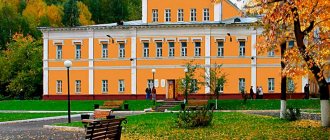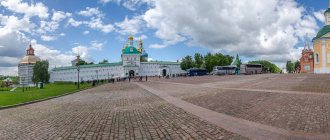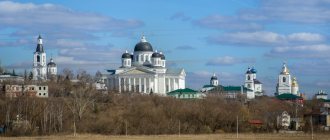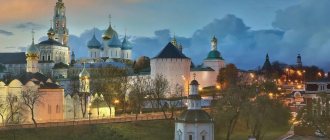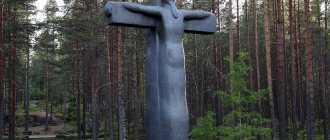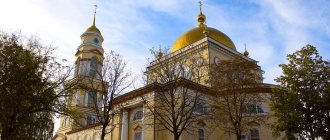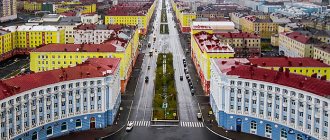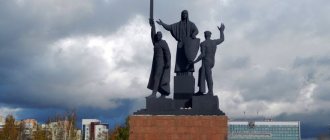Gavrilov Posad: TOP 5 most interesting places
During the imperial period of Russian history, the territory of the current Gavrilovo-Posad region belonged to the Vladimir province. The geographical location and historical monuments preserved here determine the tourism potential of the area. Since the city is small, one day is enough to explore its sights. At the beginning, the most interesting and iconic objects are presented that are definitely worth paying attention to.
Palace Stud Farm
- Address: Suzdal highway.
The main pride and symbol of the city is the stud farm. The beginning of its history goes back to the times of Ivan the Terrible. The date of foundation is considered to be 1564. In later sources it is referred to as the “Gavrilovskaya stable”. It is considered the oldest stud farm in our country.
The brick building of the stable yard, designed for 500 horses, was built in 1787. The plant existed until the end of the 1820s, and then its history was interrupted for more than half a century. It was revived as a state factory stable, where they began to breed a famous breed of horses called the Vladimir Heavyweight
The equestrian theme was reflected in the heraldry. The rearing animal is the central element of the coat of arms of the city of Gavrilov Posad.
The historical building, built in the shape of an even rectangle with a large courtyard, has survived to this day. The enterprise, which is still operating to this day, has been located in a new building located next door since 2013, where you can get to know the symbol of the city in person.
Museum and tasting complex "Palace Plant"
- Address: Suzdalskoe highway, 13.
More recently, a large-scale complex was created on the basis of a historical stud farm, thanks to which the city has become an attractive destination for lovers of gastronomic tourism. Gavrilov Posad is famous not only for horse breeding, but also for its rich drinking traditions. This is where the Bluebellies family comes from, after which a famous brand of Finnish beer is named.
The Palace Factory museum and tasting complex combines two important themes for the city. The initiator and creator was the former mayor of neighboring Suzdal, entrepreneur Igor Kekhter, who is involved in the restaurant business. There are 6 exhibitions on the territory of the complex, among which there are halls dedicated to history.
The complex includes a museum of national drinks, which is based on Kekhter’s personal collection. Tasting rooms available. By visiting the Palace Factory, you can not only get acquainted with the history of drinks, but also experience different facets of drinking culture.
In one of the halls, visitors will be offered to try drinks for each letter of the Russian alphabet. The complex pays attention not only to alcohol culture, but also to favorite non-alcoholic drinks, including those popular with children. A notable part of the exhibition was the samovar room.
Various events, master classes, and quests are held on the basis of the museum and tasting complex; it has become a point for the development of event tourism in the city.
Museum of Local Lore
- Address: st. Rosa Luxemburg, 5.
The city museum was created in 1960, the chairman of the organizing committee for its creation and the first director was I.D. Konstantinov. It took 6 years to organize the exhibition and began to receive visitors in 1966.
Nowadays the exhibition presents historical, ethnographic and natural-ecological topics. Separate rooms are dedicated to two Patriotic Wars - 1812 and the Great Patriotic War. The ethnographic sector features exhibitions illustrating the life of the different classes that inhabited the city - one of the halls is dedicated to the philistinism and nobility, the other to the peasantry. An ethnographic exposition is highlighted.
The Gavrilovo-Posad region is remarkable from an archaeological point of view; a lot of evidence of antiquity has been discovered here. Interesting finds and research results are also presented on the territory of the attraction.
Ilyinsky Compound
- Address: Pionerskaya st., 14.
The monastery temple complex is known as Ilinskoye Compound. It is located on the river banks in the historical center of the city, on the territory of the Nepashennaya Sloboda, from which Gavrilov Posad once began. The partially preserved ensemble consists of buildings from the 18th – early 19th centuries. Its appearance took shape in a more or less complete form at the turn of the century.
The main pearl of the courtyard is the Church of Elijah the Prophet. The single-domed, rather modest church has become a unique monument thanks to its decorative elements. The façade is decorated with tiles, which add elegance and mystery to the appearance of the church.
The technology for making tiles has been repeatedly studied by specialists, but it has not been possible to restore it for certain. Elias Church is a summer church; there was a winter church of the same name, of which only ruins remain. The neighboring St. Nicholas Church, also part of the courtyard, has been partially preserved. It is dated 1725.
The architectural dominant of the ensemble of the Ilyinsky Metochion and, probably, the entire central part of Gavrilov Posad is the bell tower at the Church of Elijah the Prophet. Rising above the city, the white stone structure in the spirit of classicism was used for many years as the city's water tower.
Soviet square
- Address: pl. Soviet.
The main square of the city is called Sovetskaya here. This is the center of city life and a point of attraction for tourists, where a number of remarkable architectural and monumental objects of different eras are located - imperial, Soviet and modern.
The current appearance of the square demonstrates the development of Gavrilov Posad as a tourist city. In 2021, the community won a grant for improvements, which resulted in the area being transformed. A children's playground, the Shishka pavilion, and a dry fountain appeared here.
History of the settlement
Gavrilovo-Posad urban settlement
Gavrilovo-Posad municipal district
Gavrilovo-Posadsky municipal district is located in the southwestern part of the Ivanovo region. It borders in the north with the Ilyinsky district, in the northeast and east - with the Teykovsky district, in the west, south and southeast - with the Yuryev-Polsky and Suzdal municipal districts of the Vladimir region.
From the regional center, the city of Ivanovo, the city of Gavrilov Posad is located at a distance of 80 km along the regional road Ivanovo - Teykovo - Gavrilov Posad. The reconstruction of the road connecting Gavrilov Posad with Yuryev-Polsky has been completed.
The Moscow-Ivanovo-Kineshma railway runs through the region. Gavrilov Posad station is located 75 km from Ivanovo station, and 240 km from Moscow Yaroslavskaya station.
In general, the geographical position of the Gavrilovo-Posad urban settlement should be assessed as quite advantageous, primarily due to the location of Gavrilov Posad on the railway and its direct automobile accessibility to such significant historical populated areas as Suzdal (27 km from Gavrilov Posad), Yuryev-Polsky (40 km), Teykovo (50 km), Ivanovo (80 km), Rostov Velikiy (150 km).
Currently, as a result of the local government reform in the region, two urban (Gavrilov Posad, Petrovsky village) and four rural settlements (Lobtsovskoye, Novoselkovskoye, Osanovetskoye, Shekshovskoye) have been formed from 12 rural and one village administrations, a total of 89 settlements .
The Gavrilovo-Posad urban settlement of the Gavrilovo-Posad municipal district is located in the very heart of Ancient Rus', in the Vladimir-Suzdal region. The settlement of these lands began in the Neolithic era, which is confirmed by numerous archaeological finds of monuments of the Fatyanovo culture.
Since the early Middle Ages, one of the most important sections of the ancient river system, the Great Volga Route “from the Varangians to the Arabs,” which connected Europe with the Arab East, passed through the lands of the region, namely along the Nerl River. It was a kind of bridge through which the interpenetration of cultures and intensive trade exchanges took place. The Gavrilovo-Posad land has preserved in its ancient burial mounds weapons, jewelry, coins - both Eastern and Western European, dating back to the 8th - 11th centuries. About a thousand years ago, complex ethnic processes took place here, which ultimately led to the creation of Russian statehood (Rostov-Suzdal Rus'). At the same time, the oldest Suzdal highway in the territory of our region was formed, connecting two centers of gravity - Suzdal and Rostov the Great.
With the formation of the Moscow principality, another significant trade route arose - the Stromynsky tract, which led from Moscow through Yuryev-Polsky and Gavrilovskaya Sloboda to Suzdal.
The city of Gavrilov Posad as the village of Gavrilovskoye is mentioned in the Completion (agreement) of the Great Moscow Prince Vasily Vasilyevich II the Dark with the Galician Prince Dmitry Shemyaka in 1434.
The history of horse breeding in these places dates back to very ancient times, when these lands were inhabited by Meryan tribes, for whom the horse was a totem animal. The Slavs who came to these lands multiplied horse-breeding traditions, using the horse as the main draft force in their sedentary agricultural life.
The history of Gavrilovsky Posad and the surrounding villages was closely connected with the palace stud farm, the origin of which is associated with the name of Ivan the Terrible. The first written mention of the plant is in the scribe books of Gavrilovskaya Sloboda for 1632-1633, but the first indirect mention of the sovereign's stable in Gavrilovskaya Sloboda dates back to 1587. Throughout the long history of the stud farm, the walls of the stable building and the equestrian arena were silent witnesses to the presence of hussars and “gunners” in them; they heard the shackled ringing of the tsar’s “unreliable” people who were on their way to Siberia for hard labor.
The stables of this stud farm, which adorn Gavrilov Posad to this day, are an outstanding architectural monument of Catherine’s time. The supposed author of the project was an associate of Peter I, the first Goff-bau-intendant of St. Petersburg P. M. Eropkin.
In the middle of the 20th century, a new breed of horse was bred at the State Breeding Horse - the famous Vladimir heavy draft horse.
From the first half of the 17th century, the village began to be called the Sovereign's Palace Settlement of uncultivated peasants who, after serving their term of service at a stud farm, settled nearby and opened shops or craft workshops. Documents from the mid-17th century clearly testify to the commercial and industrial activity of the peasants of the Gavrilovskaya Sloboda, who amassed initial capital from road services and peasant wholesale trade. This was facilitated by the location of the settlement at a trade crossroads and its belonging to the palace parish.
In 1789, by decree of Empress Catherine II, Gavrilovskaya Sloboda was renamed Gavrilovsky Posad and granted city rights. At the end of the 18th - beginning of the 19th centuries. the real blossoming of entrepreneurship begins. Already in 1790, the total capital of entrepreneurs in Gavrilovsky Posad was 1 million 87 thousand rubles. In 1800, there were 340 merchants and 129 burghers in Posad, with about 40 representatives of other classes.
The first enterprise with a known founding date (1775) was the starch and powder factory of G. A. Zhilin, founded in Gavrilovskaya Sloboda. At the end of the century, it produced up to a thousand pounds of powder per year, and of excellent quality, so that the powder was supplied to St. Petersburg and Moscow. Even Empress Catherine II used only this powder until her death, considering it to be the best.
The first linen factories appeared here in the 1780s. At the beginning of the 19th century, there were more than 20 merchants of the 2nd and 1st guilds in Gavrilovsky Posad. The richest of them took drinking contracts and wholesale supplies of drinks to entire provinces, and were engaged in construction contracts. Brothers Nikolai and Pavel Sinebryukhov conducted business in the St. Petersburg province, and later, in 1819, in the territory of Finland conquered from Sweden in 1808. In Helsingfors (now Helsinki), they founded a brewing company, which is still known throughout Europe.
Gavrilovsky Posad was famous for trade and noisy bazaars. For example, since the end of the 18th century, a large fair with a large turnover was held here at the beginning of June.
The lands located around the city saw the squads of the first Russian princes, epic heroes, and internecine princely strife. In 1238, the hordes of Batu passed through these lands; at the beginning of the 17th century, the Poles committed outrages here. Residents of these lands took part in the Patriotic War of 1812 and defended Port Arthur. During the Great Patriotic War, more than 13 thousand of our fellow countrymen went to the front, almost half of whom became victims of the war. Five Heroes of the Soviet Union and one full holder of the Soldier's Order of Glory were born in the region.
Among the most famous people born in the villages of the current Gavrilovo-Posad urban settlement of the region, one can single out the founder of blacksmith science in Russia, Professor AI. Zimin and his son, professor at Moscow Higher Technical University. Bauman Yu. A. Zimin, People's Artist of the USSR, actor of the Moscow Art Theater, director and screenwriter A. I. Zhiltsov, soloist of the Bolshoi Theater A. P. Lyubimov, participants in the Great Patriotic War Colonel General I. V. Shikin, Lieutenant General N. A. Romanov, Major General A. G. Komkov, Major General A. N. Konovalov, Major General Kh. V. Petrov. The life and work of a number of famous people are connected with the Gavrilovo-Posad region: the Decembrist poet A. I. Odoevsky, P. M. Bestuzheva, the mother of four Decembrist brothers Bestuzhevs, the artist and thinker N. K. Roerich. Zhiltsova A.I., in addition, in the post-war period, 506 people were awarded orders and medals for high performance in their work, three were awarded the title of Hero of Socialist Labor, about 900 Gavrilovo-Posadtsev were awarded orders and medals during the war, five were awarded the title of Hero of the Soviet Union .
OJSC "Pedigree Horse"
On the territory of the Gavrilovo-Posad urban settlement of the Gavrilovo-Posad municipal district there are many architectural monuments. The most interesting is the ensemble of the palace stud farm built in 1787 in the city of Gavrilov Posad.
The whole history of Gavrilov Posad. Closely related to the development of horse breeding. The Gavrilovo-Posad stud farm was first mentioned in the writing books of 1632-1633. Then it was called the Gavrilovskaya stable, which occupied first place among all the palace stud farms. Its main purpose was to supply the court stables, but some of the horses were sold. All stables were wooden. In 1787, a brick stable yard was completed, where more than 500 horses were kept. In 1829, the stud farm was closed and only 57 years later, on the basis of the former stud farm, the State Factory Stable was opened, which in turn became the basis for the creation of a new stud farm for breeding the Vladimir heavy draft horse. It was here that the best dams and stallions of the breed were collected. The Vladimir breed was bred on farms in the Gavrilovo-Posad, Yuryev-Polsky, and Suzdal districts and approved in 1949.
CENTER OF RUSSIAN FOLK ARTS
In the early 90s, a program for the preservation and revival of Russian national culture was adopted in the Ivanovo region. In accordance with it, by decree of the head of the administration of the Gavrilovo-Posad district dated June 17, 1993 No. 185-A, the Center for Russian Folk Art was created. The uniqueness of our Center lies in the fact that here they are engaged not only in the revival of forgotten folk crafts and trades, but also try to preserve and increase Russian folk art in general. Now the Center has 15 studios: soft and clay toys, hand weaving, painting and wood carving, artistic embroidery, lace weaving, patchwork mosaic, birch bark weaving, a fine arts studio, an orchestra of Russian folk instruments, a drama studio, straw weaving, and the Petrushka Theater ", a folklore studio in which children from 7 to 16 years old study. Upon completion of training, students take final exams and defend their theses.
Vest "Evening". Master of the bobbin lace making studio E. A. Antonova
Artistic image “Beryozonka”. Master judge “Birch weaving” Silapeteris N.V.
Set of women's clothing “Ladushka”, master I. S. Agapova.
Dolls “Old Man - Little Forester” and “Beautiful Kiki”, master T. Yu. Yakovleva.
Date created: 03-09-2012 Date last modified: 12-10-2012
Temples and monasteries of Gavrilov Posad
The settlement traces its history to the village of Gavrilovo, which is mentioned in historical documents dating back to 1434. The status of the city was received in 1789, from this date Gavrilov Posad has been counting its chronology. During its existence, quite a number of interesting and important shrines for Orthodoxy appeared here.
Temple of Michael the Archangel
- Address: Oktyabrskaya st., 28.
The single-apse, squat church with a modest dome was built in 1765 and consecrated in honor of St. Nicholas. In the 20s In the 20th century, St. Nicholas Church was closed and the building was given over to a club. The restored historical religious building became the Church of the Archangel Michael in 1990, with the return to religious life.
When reviving the temple, it was decided to name it in honor of the 18th century church that has not survived to this day. Thus, the memory of two historical churches in the city of Gavrilov Posad was embodied in one object.
Church of the Icon of the Mother of God "Burning Bush" in Borodino
- Address: Gavrilovo-Posad district, Borodino village.
The name Borodino is strongly associated with a settlement near Moscow, which went down in history as the site of the battle of 1812. In the Gavrilovo-Posad district of the Ivanovo region, the legendary village has a namesake. The local Borodino is 9 km away. from the regional center and is notable for its religious buildings.
One of the temples is not operational, but its architecture has been preserved and is an example of the eclectic style in temple construction of the second half of the 19th century. The full name of the temple is the Church of the Icon of the Mother of God “Burning Bush”; in sources it is often called simply Neopalimovskaya.
Archangel Church in Borodino
- Address: Gavrilovo-Posad district, Borodino village.
The majestic functioning church has become the hallmark of the Ivanovo village of Borodino. This is a beautiful white stone temple, crowned with a dark blue dome with gilding, consecrated in honor of Michael the Archangel.
The monument of church architecture in the classicism style is dated 1827. The appearance of the temple is organically and elegantly complemented by the bell tower. In the 21st century, the church was reconstructed; the building appeared in its current form in 2021.
Church of St. George the Victorious in Yaryshevo
- Address: st. End, 39, village of Yaryshevo.
Two kilometers from Gavrilov Posad, in the village of Yaryshevo, on the banks of the Voimitsa River, there is a temple - an architectural monument of the last third of the 18th century. In the form of a whitewashed brick church and its bell tower, two regional schools of temple architecture stand side by side. The church itself embodies the traditions of the Suzdal school, and the bell tower – the Kostroma one.
The ensemble was built by a team of specialists from St. Petersburg with funds allocated by the Palace Stud Farm. The temple has survived to this day almost in its original form, having undergone only minor reconstructions over the centuries of its history.
Church of Joachim and Anna in Shekshovo
- Address: Gavrilovo-Posad district, Shekshovo village.
The two-story church in the ancient village of Shekshovo in the vicinity of Gavrilov Posad has only partially preserved its appearance, but continues to be used for its intended purpose and receives parishioners.
The initial construction of the church in honor of Saints Joachim and Anna dates back to 1796, the second floor appeared in 1815, at the same time the façade of the bell tower underwent changes and was supplemented with porticoes.
The church is mentioned in the notes of the artist Constantine Roerich, who traveled to these places in 1902. He was amazed by the beauty of the structure and described it as “perfect 17th century”: although the temple was built later, it was consistent with historical tradition.
Spaso-Kukotsky Monastery
- Address: Gavrilovo-Posad district, Serbilovo village.
In the village of Serbilovo near Gavrilov Posad, the remains of an ancient monastery that arose approximately in the middle - last third of the 17th century have been preserved. This men's monastery is associated with a controversial historical figure - Grigory Otrepyev. This figure is shrouded in many legends, one of which represents him as a monk of the Spaso-Kukotsky Monastery.
Today there are three non-functioning churches in varying states of preservation. The main temple is considered to be the Transfiguration Cathedral, built in 1673. The object may be of interest from a historical, cultural and architectural point of view.
Church of the Nativity of the Blessed Virgin Mary in the village. Podolets
- Address: Podolets village, Ivanovo region.
At the entrance to the village of Podolets, which lies on the way from Gavrilov-Posad to Suzdal, you can see a beautiful temple built in 1816. These lands once belonged to the landowners Buturlin.
The construction of the Church of the Nativity of the Blessed Virgin Mary as a patrimonial church was initiated by a representative of this family, Ekaterina Pavlovna Buturlina, who allocated her own funds for it. Later a bell tower was added. The white stone church is topped with a rotunda-shaped dome with a dome.
Church of St. Nicholas the Wonderworker in the village. Petrovo Gorodishche
- Address: st. Lenina, 14, village of Petrovo-Gorodishche.
The one-domed church with a portico, located in the village of Petrovo Gorodishche, was built at the expense of the owner of these lands, landowner I.A. Ragozin (in other sources Rogozin) on the territory of his own estate.
The original construction dates back to 1789. It is known that the church replaced an older wooden building. Rebuilt at the end of the 20s. XIX century. In Soviet times it was closed, the bell tower at the church was destroyed. The Church of St. Nicholas the Wonderworker returned to religious activity in 1991.
LiveInternetLiveInternet
Gavrilov Posad-administrative center of the Gavrilovo-Posad district of the Ivanovo region. Population 6515 peopleStory:
Mentioned in the contract document of 1434 as the village of Gavrilovskoye. There is an opinion that the village was founded in the 13th century. and was named by the Grand Duke of Vladimir Vsevolod the Big Nest after his son Svyatoslav, who also had the Christian name Gabriel. Initially it was a settlement of the palace department, and from 1609 the state palace Gavrilov Sloboda. Gavrilovsky Posad since 1789 (and received the status of a city??). From the end of the 19th century. city of Gavrilovsky Posad, in the 20th century. city of Gavrilov Posad.
The beginning of the settlement of modern territory by the Slavs occurred in the 9th - 12th centuries. The city of Gavrilov Posad as the village of Gavrilovskoye is mentioned in the Completion (agreement) of the great Moscow Prince Vasily Vasilyevich II the Dark with the Galician Prince Dmitry Shemyaka and others in 1434. In 1789, by decree of Empress Catherine II, Gavrilovskaya Sloboda was renamed Posad, and according to its administrative status it is used city rights. From that time on, the former palace village began to be called Gavrilovsky Posad, and according to its administrative status it enjoyed city rights. In 1899, in Gavrilovsky Posad there were 2,600 people, there were 8 streets, 60 stone and 200 wooden houses, 3 Orthodox churches, a two-class school of the Ministry of Public Education, a zemstvo women's school, an almshouse, a library, a bookstore, and a stable for the state horse breeding. Some of the residents worked at a cotton-printing factory, while others were engaged in the purchase and resale of flax, agricultural weaving products and other handicrafts brought from surrounding villages. The history of Gavilovsky Posad and the surrounding villages was connected with the palace stud farm. The first mention of the plant is in the scribe books of Gavrilovskaya Sloboda for 1632 - 1633. “Yes, in the village of Gavrilova in the new settlement there is a courtyard of the sovereigns of the Stables, a courtyard of clerks, a courtyard of a groom, 2 courtyards of backyard grooms, 11 courtyards of stable grooms and 17 people in them.” To provide the plant and its employees with grain food, several villages were assigned to the plant - Staropashennaya Sloboda, Volodyatino, Gorodishchi, Voymiga, Yaryshevo, Muravkino, Zakomelye, Shekshovo and Bekserevo - 1819 male souls. To collect hay for feeding horses, floodplain meadows along the banks of the Irmes and Voymiga rivers are allocated. In total, the plant, and then the specific department, owned up to 1000 acres of land.
Economy:
Gavrilov Posad is the center of an agricultural region.
enterprises:
Textile factory Garment factory Horse class=”aligncenter” width=”699″ height=”420″[/img]
Old postcard XX century.
Stud farm today.
“Vladimir heavy truck” Gavrilov Posad (Ivanovo region)
"Vladimir heavy truck".
Shopping arcades.. Photo 1892
Railway station.
Attractions.
Church of the Intercession (mid-19th century) Located in a small area of the village, located on a gentle hill above a wide plain. The church was built in 1854 on the site of a former wooden church. An example of a traditional parish church, the monumental appearance of which is determined by the forms of the Russian-Byzantine style.
Ensemble of the Spaso-Kukotsky Monastery.
Transfiguration Cathedral in the Spaso-Kukotsky Monastery.
Vvedenskaya Church in the Spaso-Kukotsky Monastery.
Last third of the 17th century. Located in an open area, descending to a small depression. The eastern facades of the buildings face the central square of the village. Founded no later than the 16th century, it is known as the temporary refuge of Grigory Otrepiev. Named after the main cathedral (originally wooden) and the Kuksa River flowing nearby. The existing Cathedral of the Transfiguration was erected in 1673. Somewhat later, at the end. XVII century, the winter Church of the Introduction and a hipped free-standing bell tower were built. It is known that in addition to these structures that have survived to this day, the complex included the wooden Church of the Intercession (the time of its construction has not been established). The monastery was surrounded by a brick fence, dismantled in the 1940s. In the 30s XIX century Construction work was carried out in the monastery, during which, instead of the dismantled Intercession Church, a chapel was built in the Vvedenskaya Church, a porch was added to the bell tower, the covering and shape of the domes in both churches were changed. The monastery occupies a rectangular area. The ensemble is dominated by the large volume of the five-domed Transfiguration Cathedral. To the south of it stands the small one-domed Church of the Presentation. The pillar-shaped hipped bell tower located between them closes the small courtyard between them from the west and at the same time fixes the main axis of the ensemble. All structures are built of brick. The Vvedenskaya Church was whitewashed using plaster; traces of plaster were also preserved by the cathedral and the bell tower. The oldest monastery complex existing in the region. including expressive religious buildings in the style characteristic of Vladimir-Suzdal architecture of the 17th century. Transfiguration Cathedral.
Metochion of the Ivanovo St. Vedensky Monastery.
Church of St. Nicholas the Wonderworker (Iverskaya Church).
It is located on the high bank of the Nerl River, in the most elevated part of the village, near the road. Built at the expense of parishioners in 1801. A rural parish church typical for the southwestern part of the region.
Resurrection Church. It is located on the bank of the Lipnya River, at the entrance to the central part of the fir tree, granted to P.A. Tolstoy by Peter I in 1723. It was built at the expense of the parishioners in 1832 on the site of the former wooden church. Soon a separate bell tower was erected. later connected to the temple by a small porch-passage. In 1879, at the expense of the peasant A.N. Berdyaev, a chapel of St. Nicholas the Wonderworker was built in the refectory. A large temple in the style of late classicism, typical for this region.
St. George's Church. It was placed on the high bank of the Voiminga River, in the central part of the village. It was built in 1793 at the expense of parishioners and has survived to this day with minor changes. A good example of a tiered temple of the Suzdal school, the originality of the volumetric composition of which is given by the high bell tower of the Kostroma type.
Temple complex: churches of the Archangel Michael and the Burning Bush (1st third - 2nd half of the 19th century)
Church of St. Nicholas the Wonderworker (late 18th century - 1st third of the 19th century)
Holy Well of the Kazan Mother of God
Gavrilovo-Posad Museum of Local Lore
Located in a two-story brick building of the 19th century, a former merchant mansion. At first the museum had public status. Five of the most active old-timers of the city, I.V. Krylov, I.D. Konstantinov, I.I. Erokhov, I.M. Zhelobov, I.V. Shibanov, formed the core of the organizing committee formed on April 14, 1960. This date is considered to be the birthday of the Gavrilovo Posad Museum.
Local History Municipal Museum.
Modern views of the city.
New Square
Decades pass, and in quiet small towns nothing changes... almost...
Gavrilovo-Posad City Library.
City center
Local Lore Museum of Gavrilov Posad
Fire station of the city of Gavrilov Posad
Church of St. Michael the Archangel
Source…
Monuments of civil architecture
In addition to religious ones, Gavrilov Posad also has civil architectural landmarks that make up the urban development.
Fire station building
- Address: Sovetskaya Square, 3.
A noticeable element in the appearance of modern Soviet Square is an ancient building of an eclectic architectural style. There was a fire station here. The history of fire fighting in Gavrilov Posad goes back more than one and a half centuries. The first team was formed back in 1862. Along with the main building, the complex includes a building that housed stables.
Shopping arcades
- Address: Sovetskaya Square, 17.
The shopping arcade building is considered an architectural monument of the 19th century. One of the two existing buildings has reached us; its creation dates back to 1853. Historically, the building housed retail shops, taverns and drinking establishments, and there was also an inn.
The building of the former restaurant of merchant Bessonova
- Address: st. III Internationala, 18.
The two-story colorful brick building is located along 3rd International Street. The architectural appearance is distinguished by decorative elements of the facade, arched windows in the central part and a stepped attic. This building from 1900 is the legacy of the local noble merchant K. Bessonova. It was built as a restaurant.
Where to go for tourists in Gavrilov Posad
Of course, every city can show a lot of interesting things to tourists. The Palace of Culture library and the Creativity Center are suitable places for entertainment and places to take a walk in Gavrilov Posad.
City Library
- Address: st. 3rd International, 18.
Nowadays, the historical building of the merchant Bessonova’s restaurant houses one of the most significant cultural institutions in the city. The Gavrilovo Posad City Library is a landmark in itself. The institution is over 120 years old. It is believed that it was founded in 1898 through the efforts of the secretary of the local government, I. Nikiforov.
Nowadays, in accordance with modern realities, a library is not only a temple of reading and a department for issuing literature at home, but also a place for holding public and educational events and excursions.
House of Culture
- Address: Sovetskaya Square, 9.
The building of the city house of culture, built in 1962, embodies the images of Soviet-era architecture on the main city square. This is the main concert venue of the city, where performances by groups and artists of various ranks take place. There is a cinema hall inside.
Various club associations operate on the basis of the recreation center. The building recently underwent reconstruction, which became necessary after the 2010 accident and several years of inactivity. In 2019, the cultural center appeared in a new look and continues to fulfill its functions.
Center for Russian Folk Art
- Address: Sovetskaya st., 18.
The traditions of folk arts and crafts in the Gavrilovo-Posad lands are preserved and developed by the Center for Russian Folk Art. The institution was created in 1993 in accordance with the state program for the revival of Russian culture. The center has children's sections of various profiles, master classes and events aimed at popularizing folk craft and artistic traditions.
People associated with the city
- Zhiltsov Alexey Vasilievich (1895-1972) - actor, director, Moscow Art Theater, People's Artist of the USSR (1968).
- Mikhail Ivanovich Mosyagin (born 1949) - Candidate of Pedagogical Sciences, Associate Professor of the Higher Accreditation Center, Honorary Worker of Higher Professional Education, currently lives in the city of Dedovsk, Moscow Region.
- Neboronov, Vladimir Ivanovich (1937-2006) - Master of Sports of the USSR in football, Honored Coach of Russia, famous sports functionary.
- Sinebrykhov, Nikolai Petrovich (1788-1848) - Russian merchant, founder of the Finnish brewing company Sinebrychoff.
- Terentyev, Sergei Vladimirovich (born 1964) - Soviet and Russian rock musician; guitarist and songwriter. He is best known as the guitarist of the group “Aria”, with whom he worked from 1995 to 2002. Currently he is the leader of the Artery group.
What to see in Gavrilov Posad from monuments
Reminders of the past here, as in other cities of Russia, are memorable places - monuments, memorial compositions and genre sculptures.
Memorial of the Great Patriotic War
- Address: Alley of Heroes.
In the center of the city of Gavrilov Posad there is a Walk of Fame adjacent to Oktyabrskaya Square. There is a monument dedicated to the memory of those who fell in the Great Patriotic War.
The military memorial is a monument in the form of a figure of a Soviet soldier; next to it on a pedestal there is a small stele crowned with a star and entwined with a laurel wreath. Thus, in the sculptural composition it was possible to combine popular symbols of valor, warfare and victory.
Monument to the Vladimir heavy truck
- Address: square of Rosa Luxemburg street.
In 2021, in preparation for the celebration of the 230th anniversary of the official founding of Gavrilov Posad, the symbol of the city appeared in the form of a monument. The author of the sculptural statue of the horse was Ivanovo sculptor I.V. Bychkov. The name of this master is quite well known in the region. Based on the model he made, the monument was cast in the ArtKont workshop.
Monument to firefighters
- Address: Sovetskaya Square.
Near the Fire Station in the city there is a sculpture depicting a representative of this noble profession. The monument appeared in the city with the assistance of the Ministry of Emergency Situations as part of events related to the “Year of Safety,” which was announced in 2021.
Story
The city of Gavrilov Posad as the village of Gavrilovskoye is mentioned in the Completion (agreement) of the Great Moscow Prince Vasily Vasilyevich with Prince Dmitry Yuryevich Shemyaka in 1434. The history of Gavrilovsky Posad and the surrounding villages was closely connected with the palace stud farm, the origin of which is associated with the name of Ivan the Terrible. The first written mention of the plant is in the scribe books of Gavrilovskaya Sloboda for the years 1632-1633, but the first indirect mention of the sovereign's stable in Gavrilovskaya Sloboda dates back to 1587.
City status was granted by Catherine II in 1789. At that time, city status was assigned if the total capital of the merchants of a given locality exceeded 100,000 rubles.
In 1941, the State Pedigree Horse Breeding Nursery of the USSR People's Commissariat for the Brabançon and Clydesdale breeds was located in the city of Gavrilov Posad.
Neighborhoods of Gavrilov Posad: archaeological sites
In the vicinity of the regional center, tourists often come across archaeological monuments.
Village Shekshovo
- Coordinates on the map: 56.532201, 40.187787.
The village of Shekshovo is not only remarkable for its beautiful old church; several archaeological monuments dating back to the Russian Middle Ages have been discovered in its area - a settlement with an area of 30 hectares and a burial mound. The local antiquities were first explored in the 19th century by the expedition of Count Uvarov.
This part of the so-called Suzdal Opolye has traditionally attracted archaeologists. Work here was carried out in different years. One of the memorable finds made in 2011 was a hatchet. According to one version, the weapon belonged to Prince Boris Vladimirovich, but not all historians share this opinion.
Settlement Maloye Davydovskoe
- GPS coordinates: 56.522902, 40.217980.
Near the settlement of Maloye Davydovskoye, on the right bank of the Nerl River, there is an ancient settlement. The remains of dwellings from different historical periods have been discovered here. The most ancient ones are correlated with the Dyakonovo culture of the 4th – 6th centuries, as evidenced by samples of ceramic products and some other finds. The later layers of the settlement, in particular, fragments of semi-dugout type buildings, date back to the 8th – 12th centuries.
Nature of Gavrilovo-Posad region
In the area of Gavrilov Posad, tourists also have access to several natural attractions where they can stroll, relax, take an evening stroll, or go fishing.
Lake Bolshoye Ivankovskoye
- Coordinates: 56.686944, 40.071667.
Near the village of Ivankovskoye, Gavrilovo-Posad district, surrounded by peat bogs, there is a reservoir that arose as a legacy of a glacier. The lake is rich in fish and is home to some wetland game and mammals such as otter and muskrat. A great place to unite with wild nature. Recognized as a natural monument: the water area and coastal zone are under protection.
Rivers Nerl and Irmes
The famous Nerl River, which is a tributary of the Klyazma, flows through the territory of the Gavrilovo-Posad district.
To avoid confusion with the reservoir of the same name flowing from the Volga, this river is sometimes called the “Malaya Nerl”. Within the boundaries of Gavrilov Posad itself runs the Irmes River, which in turn is a tributary of the Nerl. The 74-km-long water artery carries its waters through the lands of two regions - Vladimir and Ivanovo regions. The river also has a second name - Irspis.
Both reservoirs are held in high esteem by local fishermen. Walking along the banks in the vicinity of the city, you can enjoy beautiful views of Russian nature.
Gribanovsky holy well
- Address: Gribanovo tract.
A dug well located three kilometers from the village of Novoselki is recognized as a natural monument of local importance. The object has cult significance. The well was consecrated in honor of the Kazan Icon of the Mother of God.
The area around the site is known as the Gribanovo tract, after the name of the now defunct village. The source itself is called the “Holy Spring” or “Gribanovsky Holy Well”.
Don't miss guides to the sights of other cities in the Ivanovo region - Palekh, Shuya, Yuryevets, Kineshma, Ples and Ivanovo
Gavrilov Posad is located inside the Golden Ring of Russia, but, as a rule, it is not included in the travel route, and yet there are many places in the city and its surroundings that can arouse the interest of tourists.
